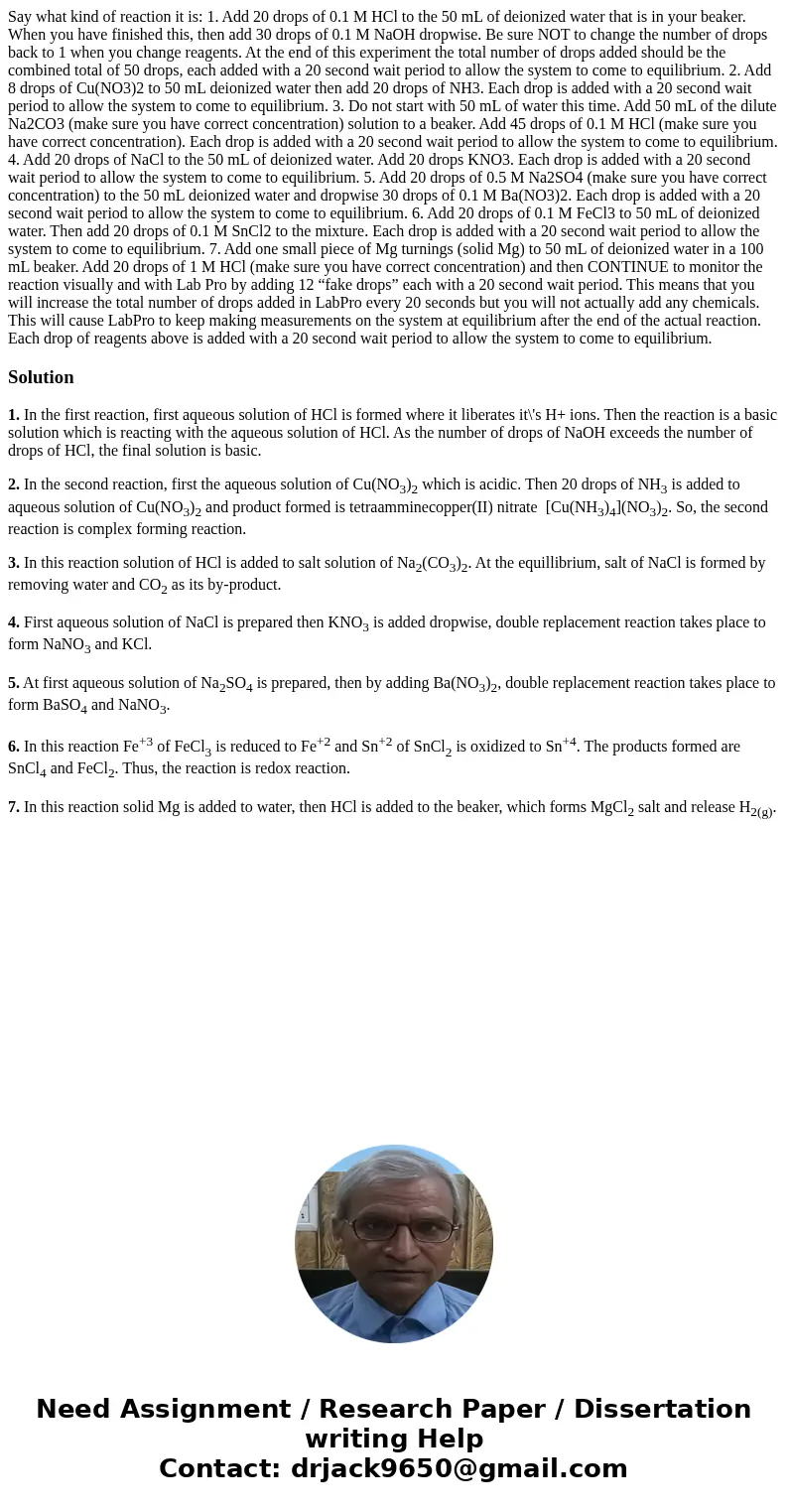Say what kind of reaction it is 1 Add 20 drops of 01 M HCl t
Say what kind of reaction it is: 1. Add 20 drops of 0.1 M HCl to the 50 mL of deionized water that is in your beaker. When you have finished this, then add 30 drops of 0.1 M NaOH dropwise. Be sure NOT to change the number of drops back to 1 when you change reagents. At the end of this experiment the total number of drops added should be the combined total of 50 drops, each added with a 20 second wait period to allow the system to come to equilibrium. 2. Add 8 drops of Cu(NO3)2 to 50 mL deionized water then add 20 drops of NH3. Each drop is added with a 20 second wait period to allow the system to come to equilibrium. 3. Do not start with 50 mL of water this time. Add 50 mL of the dilute Na2CO3 (make sure you have correct concentration) solution to a beaker. Add 45 drops of 0.1 M HCl (make sure you have correct concentration). Each drop is added with a 20 second wait period to allow the system to come to equilibrium. 4. Add 20 drops of NaCl to the 50 mL of deionized water. Add 20 drops KNO3. Each drop is added with a 20 second wait period to allow the system to come to equilibrium. 5. Add 20 drops of 0.5 M Na2SO4 (make sure you have correct concentration) to the 50 mL deionized water and dropwise 30 drops of 0.1 M Ba(NO3)2. Each drop is added with a 20 second wait period to allow the system to come to equilibrium. 6. Add 20 drops of 0.1 M FeCl3 to 50 mL of deionized water. Then add 20 drops of 0.1 M SnCl2 to the mixture. Each drop is added with a 20 second wait period to allow the system to come to equilibrium. 7. Add one small piece of Mg turnings (solid Mg) to 50 mL of deionized water in a 100 mL beaker. Add 20 drops of 1 M HCl (make sure you have correct concentration) and then CONTINUE to monitor the reaction visually and with Lab Pro by adding 12 “fake drops” each with a 20 second wait period. This means that you will increase the total number of drops added in LabPro every 20 seconds but you will not actually add any chemicals. This will cause LabPro to keep making measurements on the system at equilibrium after the end of the actual reaction. Each drop of reagents above is added with a 20 second wait period to allow the system to come to equilibrium.
Solution
1. In the first reaction, first aqueous solution of HCl is formed where it liberates it\'s H+ ions. Then the reaction is a basic solution which is reacting with the aqueous solution of HCl. As the number of drops of NaOH exceeds the number of drops of HCl, the final solution is basic.
2. In the second reaction, first the aqueous solution of Cu(NO3)2 which is acidic. Then 20 drops of NH3 is added to aqueous solution of Cu(NO3)2 and product formed is tetraamminecopper(II) nitrate [Cu(NH3)4](NO3)2. So, the second reaction is complex forming reaction.
3. In this reaction solution of HCl is added to salt solution of Na2(CO3)2. At the equillibrium, salt of NaCl is formed by removing water and CO2 as its by-product.
4. First aqueous solution of NaCl is prepared then KNO3 is added dropwise, double replacement reaction takes place to form NaNO3 and KCl.
5. At first aqueous solution of Na2SO4 is prepared, then by adding Ba(NO3)2, double replacement reaction takes place to form BaSO4 and NaNO3.
6. In this reaction Fe+3 of FeCl3 is reduced to Fe+2 and Sn+2 of SnCl2 is oxidized to Sn+4. The products formed are SnCl4 and FeCl2. Thus, the reaction is redox reaction.
7. In this reaction solid Mg is added to water, then HCl is added to the beaker, which forms MgCl2 salt and release H2(g).

 Homework Sourse
Homework Sourse